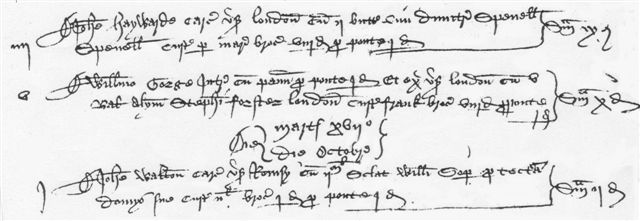About the Brokage Books
What are the Brokage Books, and why are they important?
Southampton was unusual in charging tolls on goods leaving the town by road, exceptional in making records of them, highly exceptional in the detail that was recorded, and unique in the survival of these records (the Brokage Books) amongst Southampton’s civic archives.
The Brokage Books were the work of the broker, a town official based at the Bargate (the North gate), through which carts were funnelled from the town. The broker was responsible for collecting three dues:
-
Petty customs, a fee payable on imports that had not been charged on entry to Southampton by sea. This demanded specification of the commodities and their quantities.
-
Brokage, a fee originally for arranging the haulage of goods, which varied according to the distance travelled. This explains a key feature of the Brokage Books that makes them so valuable for internal trade, the record of the intended destination.
-
Pontage, a toll of 1d on all vehicles entering or leaving the town. This was payable by all carts, even those of Southampton that were exempt from petty customs and brokage, and captured goods entering as well as leaving the town.
For thirty-eight different years between 1430 and 1540 brokage was levied on several thousand carts; the names of carter and owner, the destination, and the contents of each cart were carefully recorded in Latin in the Southampton Brokage Books.

Translation
John Haywarde carting towards London with 2 butts of wine for Demetrious Spinnelli, custom paid at sea, brokage 8 pence and pontage a penny total = 9 pence.
William George entering with cloth, pontage 1 penny and leaving towards London with 5 bales of alum for Stephen Forster of London, custom free, brokage 8 pence, pontage 1 penny (out /in) total = 10 pence
Tuesday 17th day of October
John Walton carting towards Romsey with 2,000 slates for William Soper for the roof of his house. Custom nil, brokage 1 penny, pontage 1 penny, sum total tuppence.
Despite certain limitations, the Brokage Books are the best record for the trade of Southampton with its hinterland, for the inland trade of central southern England and of every significant place within it, and are also the best record for English inland trade before the 18th century.





